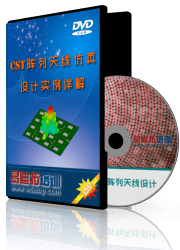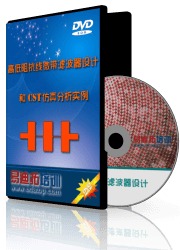- 易迪拓培训,专注于微波、射频、天线设计工程师的培养
Circular Horn Antenna - CST2013 MWS Examples

General Description
This example shows the calculation of farfields and electric fields of a horn antenna. The antenna consists of a rectangular waveguide, which is connected with a circular horn by the loft feature. Also the setup of result templates is shown, which are stored during parameter sweeping and optimization runs.
Structure Generation
The antenna is created using a basic brick and cylinder. More advanced operations are the usage of the local working coordinate system before defining the cylinder and especially the loft operation to connect rectangular and circular faces. At the end (after boolean adding the 3 individual objects), the Shell-feature is applied to create a finite wall thickness.
Solver Setup
A waveguide port is defined on the open side of the rectangular waveguide to stimulate the antenna. All calculation domain boundary conditions are set to "open". Magnetic and electric symmetry planes are used to reduce the calculation time. Besides standard e-field and farfield monitors also a Result Template is setup to store and compare the farfield gain during mesh adaption runs, parameter sweeping or optimization runs.
Post Processing
The electric field distribution can be accessed in the navigation tree in the subfolders of 2D/3D Results  E-Field. The farfield patterns are listed in subfolders of Farfields in the navigation tree. For the farfield, the phase center calculation has been activated. The phase center is determined for the phi component within the xz plane, i.e. the H plane in an angular width of 15 degree around the main lobe direction. To cross check the phase center position, it is entered as origin in the farfield plot dialog. Switching the coordinate system to Ludwig 3 in the axis tab, changing to E field in the plot mode tab of the farfield plot dialog and selecting the Ludwig 3 Vertical Phase component in the navigation tree, one can see the constant phase around the main lobe.
E-Field. The farfield patterns are listed in subfolders of Farfields in the navigation tree. For the farfield, the phase center calculation has been activated. The phase center is determined for the phi component within the xz plane, i.e. the H plane in an angular width of 15 degree around the main lobe direction. To cross check the phase center position, it is entered as origin in the farfield plot dialog. Switching the coordinate system to Ludwig 3 in the axis tab, changing to E field in the plot mode tab of the farfield plot dialog and selecting the Ludwig 3 Vertical Phase component in the navigation tree, one can see the constant phase around the main lobe.

In addition, the temporal development of the electric phi and magnetic theta component recorded by the farfield probes can be studied in the 1D Results  Probes
Probes  E-Farfield and 1D Results
E-Farfield and 1D Results  Probes
Probes  H-Farfield folders of the navigation tree.
H-Farfield folders of the navigation tree.
CST微波工作室培训课程套装,专家讲解,视频教学,帮助您快速学习掌握CST设计应用
上一篇: Dipole Antenna Array - CST2013 MWS Examples
下一篇: Corner Reflector - CST2013 MWS Examples
CST婵犵數鍋為崹鍫曞箹閳哄懎鍌ㄥù鐘差儏閸戠娀鏌涢幇鍏哥凹闁哥姴妫濋弻娑㈠焺閸愌呯箒闂佸搫妫庨崕鐢稿蓟濞戙垹鐓涢柛鎰亾閺侇垰顪冮妶鍡樼叆閻庢碍婢橀锝夘敃閳垛晜鐎婚梺鐟扮摠濮婂綊鎮¢敓锟� | More...
 最全面、最专业的CST微波工作室视频培训课程,可以帮助您从零开始,全面系统学习CST的设计应用【More..】
最全面、最专业的CST微波工作室视频培训课程,可以帮助您从零开始,全面系统学习CST的设计应用【More..】
频道总排行
- Rectangular Waveguide Tutorial
- FSS: Simulation of Resonator
- CST2013 MWS Examples: Thermal C
- Dipole Antenna Array - CST201
- CST MWS Examples - CST2013 M
- Microstrip Radial Stub - CST2
- Dielectric Resonator Antenna -
- Interdigital Capacitor - CST20
- CST2013 MWS Examples: Biological
- Lossy Loaded Waveguide - CST2










